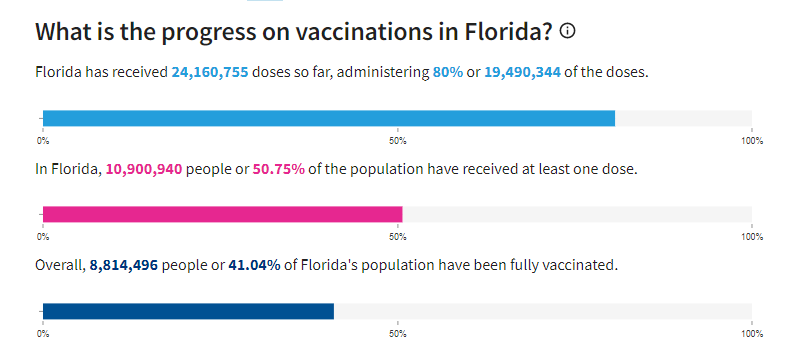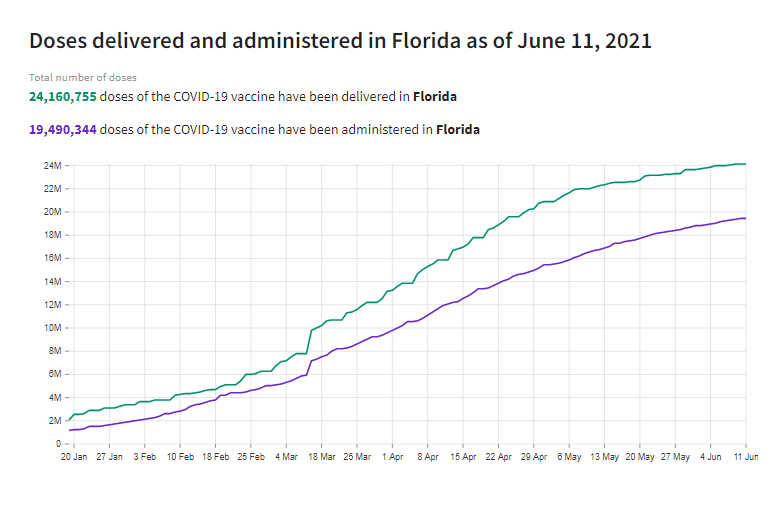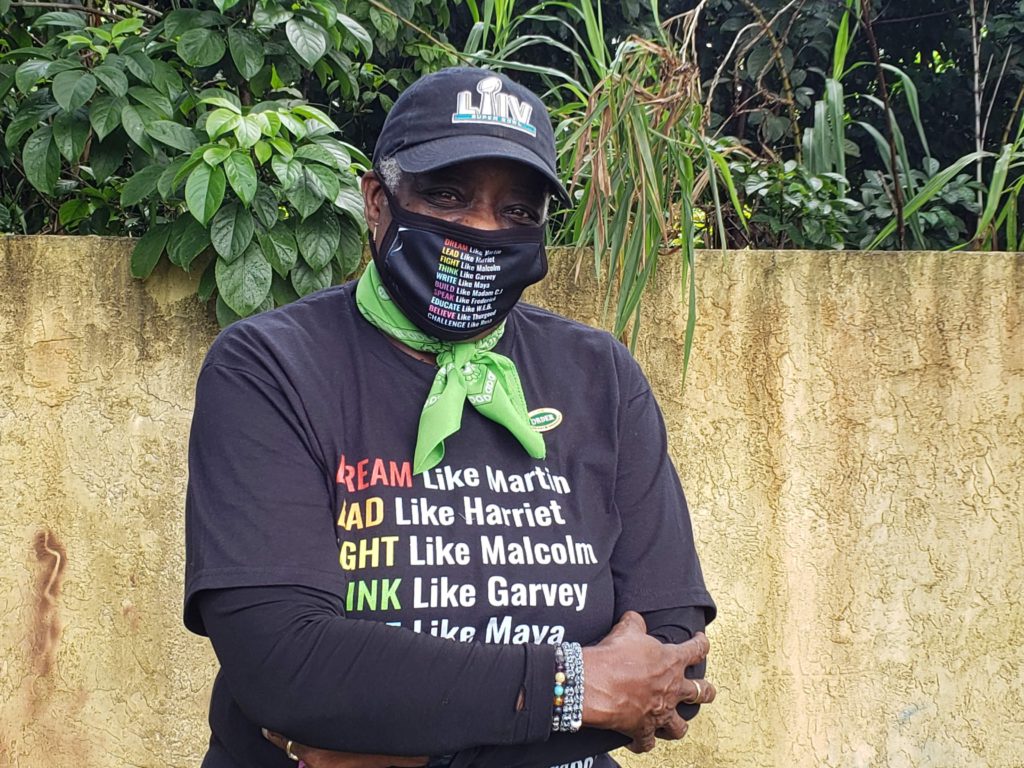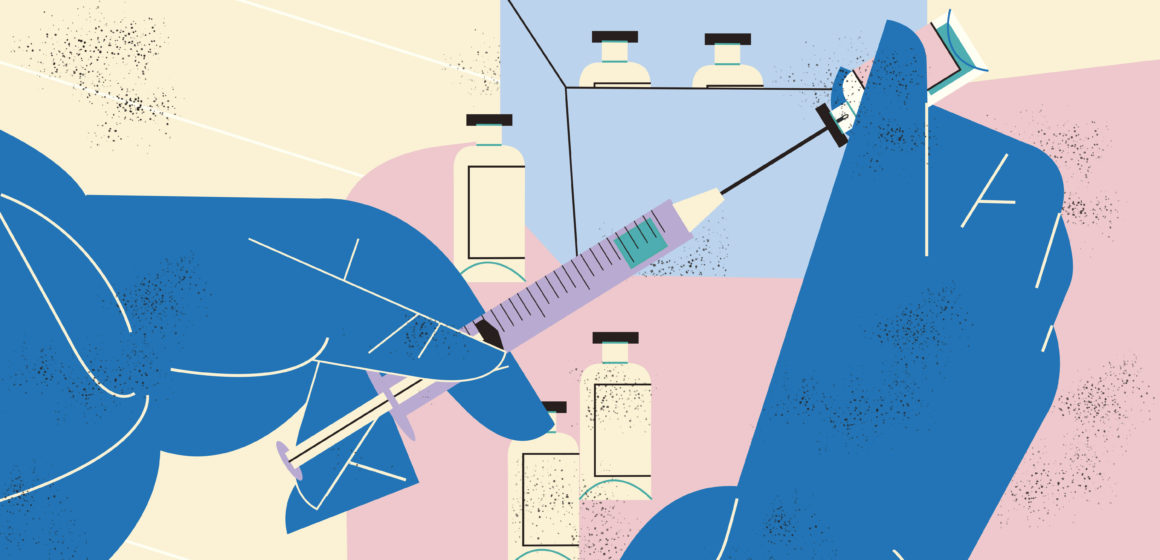Notwithstanding a high population rate of Hispanic descent, the Sunshine State, controlled by the Republican party, ranks third in distribution of COVID-19 vaccines among the US states with large Hispanic communities. In addition, it has the fourth most unequal apportionment of vaccines for African Americans.
The uneven ratio of COVID-19 immunization for Hispanics and African Americans is far away from the nationwide goal of short-term protection for the minorities, particularly vulnerable to the pandemics, as the Nation reopens and the virus mutates.
With a notably heterogeneous population, Florida occupies the third position in distribution of vaccines for Hispanics among the US states with the largest Hispanic population overall. Also, it ranks fourth in the list of the US states with the most unequal apportionment of vaccines for African Americans.
As the new Coronavirus mutates and with the emergence of different strains, public health experts fear that the impact on the non-vaccinated may be far more serious.
In this scenario, it is unclear whether the United States of America will reach the longed-for threshold of collective immunity, let alone the minorities.
ITEMP’s assessment of data from the Centers for Disease Control and Prevention (CDC) and the Florida Department of Health found that the Hispanic access to COVID-19 vaccines is fairly restricted, compared with the states of California and Texas. This also holds true for the rest of US states, where the number of Hispanic residents is decidedly inferior to the number of Caucasians, African Americans or Asians.
While at June 4, 2021, a total number of 169.7 million, or 51.1% of the US population, had received at least one shot of the COVID-19 vaccine, the government target of immunization at 70% by July 4, 2021 looks complicated in view of the delay in the racial minorities, where social issues make a difference.

As regards Florida, public health and population experts have urged the Republican administration of Governor Ron DeSantis to speed up and augment immunization campaigns and incentives in low-income or hardly accessible areas.
Still another glitch found by ITEMP is that the non-availability of broken-down statistics in Florida Department of Health impedes experts and researchers from focusing their studies per race, ethnics and county so as to ensure the urgent supply of vaccines.
A spokesperson of the Florida Department of Health declined to handle the queries from ITEMP, and the Office of the Governor of Florida made no comments on punctual matters.
In Florida, 10.6 million or 49% of local residents have received at least one dose of the COVID-19 vaccine. Altogether, 8.5 million or 39% had been fully vaccinated at June 4, 2021.
As few as 1.8 million in the first cohort were of Hispanic descent, that is, 29%.
And while African Americans account for 17% of Florida population, they suffer the brunt of cuts, with 753,000 vaccines only.
According to Dr. Mary Jo Trepka, an infectious disease epidemiologist at Florida International University (FIU) Robert Stempel College of Public Health and Social Work: “Among those vaccinated in Florida (i.e., had at least one dose) for whom we have data on race, about 9% are African American so that population is underrepresented among vaccinated people.”
The scholar noted misinformation among those vaccinated in Florida, and she also stressed the need to undertake a true awareness and promotion campaign.
In her view, “The caveat is that we are missing race information for 25% of people who were vaccinated.”
“To address this problem, I think that it is very important that local leaders and local health departments in each county of Florida work together to identify neighborhoods with low vaccination rates and work with those neighborhood leaders to identify barriers (e.g., knowledge or logistic problems like transportation) and address them,” the expert added.
While the number of Hispanics infected by COVID-19 in Florida neared 42% out of the total population in the state of Florida at the end of May 2021, only 29% had received at least the first dose.
In the words of Dr. Eneida Roldan, a professor at the FIU Faculty of Medicine, “There is a combination of factors when explaining immunization numbers in Florida; nothing is like cause and effect in these cases. The Hispanic and African American populations have their doubts about the vaccine and they frequently don’t show up to receive it.”
“When we look at these groups, we can note that they are usually low-income and have troubles to receive the vaccine,” Roldan said.
“It is a combination of resistance to the vaccines, just because they are not hearing scientific data; perhaps they don’t understand or simply refuse to accept it,” the professor added.
At 2020, around 5.7 million Hispanics —mostly Cubans, Venezuelans and Colombians— lived in the Sunshine State, particularly in Miami, according to Florida Census Bureau.
Florida is the third US state with the largest Hispanic population, after California (15.6 million) and Texas (11.5 million).
Nevertheless, in both California and Texas, the vaccine schedule is making headway with their most representative minorities, preventing a wider racial inequality in terms of public health in the short term.
“Florida is a national embarrassment in equitable vaccinations,” Jaclyn Karasik conceded. For the biologist and epidemiologist, the issue of substance has to do with a discrimination policy.
“Many have harped on vaccine hesitancy as the major driver for lack of uptake, but it’s not just hesitancy — it’s systemic racism, discrimination and lack of investment in vaccine outreach strategies,” the public health expert wrote in the Sun Sentinel.

Source: CDC/USAfacts.org
While at least the first dose has been administered to 45.8% of the Hispanic residents in Iowa, i.e., 4% out of the state population, in Alabama, Hispanics have received 5% of the vaccines, far higher than the death rate of 2%, similar to the case rate of 5% and the state population rate of 4%.
In percentual manner, Iowa, Maine and Missouri have taken the lead in immunization of their Hispanic communities, actually a minority. Together with California, New York and Texas —with a vast majority of Hispanic residents for that matter— all of the six of them are among the top ten in COVID-19 immunization. Florida ranks 15 in the list, behind Nebraska.
CDC reports collected by Kaiser Family Foundation show that at May 25, 2021, information on race and ethnicity was provided for about 56% of those vaccinated with at least the first dose, thus allowing to track the progress made as to minorities nationwide.
This group included 62% Caucasians, 14% Hispanics, 9% African Americans, 6% Asians, 1% Indian Americans or natives of Alaska, and less than 1% natives of Hawaii or other Pacific Islanders.
Trial and error
If something is to define the essence of Florida, that is the Hispanic makeup, particularly in Miami. However, the state has been significantly overtaken by other US states concerning the number of COVID-19 vaccines administered to their minorities.
As per the CDC data reviewed by ITEMP, 34.8% of Hispanic residents in Los Angeles, California, had been vaccinated as of June 2021, followed by 29% in Houston, Texas.
As of June 1, 2021, in Miami-Dade County, about 804,000 out of its two million Hispanic residents had received at least the first shot of the COVID-19 vaccine, i.e., 27% of the total Hispanic population in the state of Florida.
Local authorities point to vaccination outreach strategies in all communities, no matter race, gender or migration status. The latter is a key issue insofar as undocumented immigrants fear punishment in the event of showing up for the vaccination.
“After the process (vaccination) was made equal for everybody, we have arranged communication and information campaigns for people to have access to the vaccine, and our efforts focus on the fact that any individual willing to get vaccinated can do it, but we cannot force anybody,” Soledad Cedro, Communications Director of the Major of Miami-Dade, said.
Eneida Roldan, the professor of Medicine, is also the clinical director of COVID-19 testing in Miami-Dade County. From her experience with local residents, she can tell that ignorance and myths are the major problem around immunization.
“How can we break down the barriers? That is the question,” the expert wondered. “I have learned about patients that received the flu shot and do not want the COVID-19 vaccine, and some others never received the flu shot, but they want the COVID-19 vaccine.”
The CDC and the schools of Medicine across the United States have embarked upon a project intended to introduce scientific experts to Hispanic and African American communities. The purpose is to deliver information to these audiences for them to grasp the importance of vaccination.
Ms. Angie Torson is an African American born in Washington, D.C. She has lived in Florida for more than forty years.
Until fairly recently, she was reluctant to immunization on the basis that vaccines had been manufactured to impair or abate US black people, or even to use humans as guinea pigs for trials of drugs — part of a myriad of conspiracy theories that sprouted from the pandemics.
Ms. Torson, 70, resolved to receive her vaccine last May, after hearing that an increasing number of people around her, including her fellow church members, were “starting to trust in science.” In her own words, “We realized that all of us are at risk and there is no distinction. I think that defeating such fear moved me to go ahead.”
At the end of May, CDC data also revealed that the shots were reaching a wider proportion of the Hispanic, Asian and African American peoples.

Experts of the Kaiser Family Foundation reckon that more than one in every five doses (23%) in the last 14 days of May had been administered to Hispanics, 8% to Asians, and 10% to African Americans.
Such trend suggests a narrower racial gap all over the United States, particularly on behalf of Hispanics, considering that a higher proportion of them have received the vaccine as compared to the total population (32% vs. 17%).
A vast majority of experts concur with each other that the troubles in Florida to “catch” the Hispanic or African American communities have to do with outreach beyond the Governor’s authority.
“To address this problem, I think that it is very important that local leaders and local health departments in each county of Florida work together to identify neighborhoods with low vaccination rates and work with those neighborhood leaders to identify barriers (e.g., knowledge or logistic problems like transportation) and address them,” Mary Jo Trepka, the FIU epidemiologist, recommended.
Jaclyn Karasik is a graduate student in the Gillings School of Global Public Health at the University of North Carolina at Chapel Hill. For her, a fairly social approach to the immunization strategy in Florida seems to be the right track to benefit Hispanic or African American majorities.
“The state’s move to open up vaccine sites for walk-ups was an excellent way to promote inclusion. To continue this momentum, we must adopt mobile clinics and extended hours to reach those facing geographic and scheduling barriers. We need to reach single mothers, people who work multiple jobs, and families who rely on public transportation,” Karasik said.
Particularly in Miami and generally in Florida, where the arrival of visitors on a daily basis poses a major risk of any disease, the new Coronavirus does not make a racial or social distinction as to propagation or death.
Dr. Roldan served as the CEO of the Jackson Health System, one of the largest health and safety networks in the United States. A such, she has firsthand knowledge of the havoc wreaked by the pandemics in the Hispanic and African American communities in the state of Florida.

“Among the things that people are not looking at is the changing genetics in this kind of virus. Certainly, the vaccine has proved to be effective against genetic changes inside the virus. Then, let me say that, yes, they are going to be vulnerable for the kind of virus we knew one year ago, but also when this virus starts to change. The vaccine is doing well as to the virus own variants.”
Dr. Roldan hints that the lot of approved and existing vaccines will continue to expand and update their viral load. “People who are not been vaccinated will be exposed to a harmful disease and what we are seeing right now is the post-COVID syndrome.”
Carlos A. Rodríguez was a collaborator in this article


